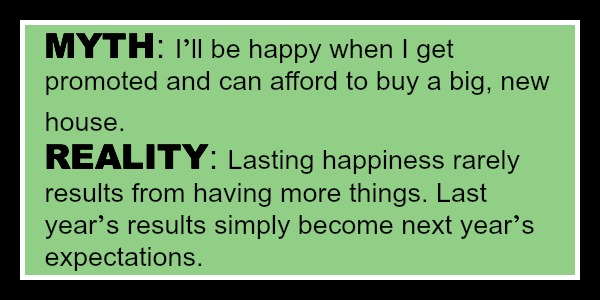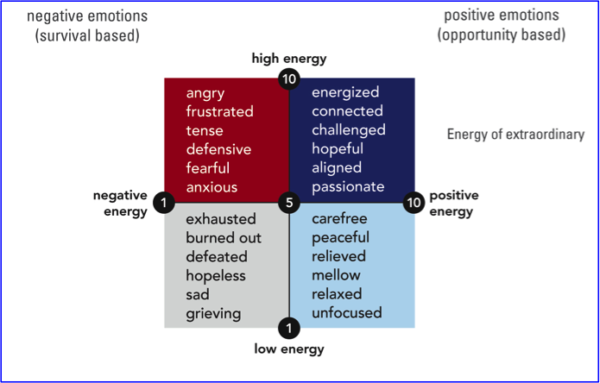The fully engaged leader can harness and expand his or her physical, emotional, mental and spiritual energy. Last week, we talked about the importance of physical energy for the fully engaged leader.
This week, expert Tom Ward, founder, and principal of Next Level, will discuss emotional energy—what it is, why it is important and how to expand it.
How to Fully Engage Emotionally
Guest post by Tom Ward

One of the greatest lessons I’ve learned in life is that lasting happiness has humble origins. For me, it starts with gratitude. Yes, gratitude. For the people in my life – my family, friends, colleagues, and acquaintances – and the abundance I’ve been afforded.
Before I attended the Corporate Athlete® course at the Human Performance Institute, I had the good fortune to meet Shawn Achor and read his book, The Happiness Advantage. In the book, which is rooted in the emergent discipline of positive psychology, Shawn discusses how the set a goal–work hard–achieve the goal–be happy formula for happiness simply doesn’t work.
Paraphrasing Shawn, “after achieving a goal, the goal posts simply get pushed farther away making continued happiness harder to achieve and maintain.” The key to happiness, he says, is to re-write the happiness formula as follows, be happy–set a goal–work hard–achieve the goal. Research shows that Shawn’s approach not only yields greater and lasting happiness but also yields greater achievements and, more importantly, stronger relationships.
So how do we re-write our happiness formulas? For me, as I’ve said, it starts with gratitude. For you, it may start elsewhere. Before recommending some strategies, you might use to help you re-write your formula, it’s instructive to review some emotional energy fundamentals.
Emotions Matrix
Every emotion we experience has a purpose. Some emotions, to be sure, are not the most pleasant or productive. Nonetheless, all of them serve some function. For me, understanding the nature of emotional energy provides useful guidance for how to better manage it.
The following matrix is from the Corporate Athlete® Course and it portrays emotional energy. On the Y-axis is the quantity of energy – low to high. And, on the X-axis, is the quality of energy – negative to positive.
When we’re in the low-negative quadrant, we need to be mindful of disengagement and burn out. Being in this quadrant is sometimes necessary, yet staying here can be harmful.
High-negative energy often results in emotional hijacking and fight or flight behaviors. Staying in this quadrant too long can be toxic.
I like to think of low-positive energy as beach time, while high-positive energy is the energy of the extraordinary. When we think of applying the principal of oscillation (discussed in the last post), it’s ideal to think of oscillating between high-positive and low-positive emotional energy.

© Human Performance Institute Division of Wellness & Prevention, Inc.
Three Strategies to Foster a More Positive Mindset
Armed with knowledge of the fundamentals of emotional energy, what are some strategies we can employ to foster a more positive, happiness-inclined mindset?
- Journaling
My favorite strategy is gratitude journaling, as it serves to ground my thinking in the here and now, the positive, and the abundance of my life. Here’s what I do. I grab my journal and find a quiet room, often my home office. Then I write two or three sentences about three people or experiences for which I am truly grateful. I do this three times each week, trying not to repeat any entry. I share my entries with my significant other on a routine basis, and she shares hers with me. The sharing part is key for me because the two of us get to know each other more fully and our relationship deepens through our sharing. - Mindfulness
If journaling isn’t your thing, I have friends who find mindfulness meditation helpful. Others use deep breathing as a means for calming the body and reorienting the mind. I find exercise of any kind keeps me in a positive frame of mind. - Acts of Kindness
Another exceptionally effective strategy is performing conscious acts of kindness. While random acts of kindness (e.g., opening the door for a stranger) are useful too, consciously and purposefully performing acts of kindness is a particularly effective strategy for promoting positivity and wellbeing. Some examples might include calling your fifth grade teacher and thanking her for the patience she modeled during your formative years; writing a former colleague and thanking him for teaching you how to be a better team member; or helping a neighbor paint the trim on her house. There are countless opportunities.
Lasting happiness and positive emotional energy begin with the awareness of what it takes to get there. The right formula is essential. So is having an effective strategy and executing it repeatedly.
Stay tuned for next week when we will dive into the next level of the pursuit of fully engaged leadership: the expansion of mental energy.
In the meantime, is emotional energy something you actively cultivate? Have you experimented with the strategies outlined above? We’d love to hear about your experience.
Let’s share experiences. Leave a comment below, send me an email, or find me on Twitter.

